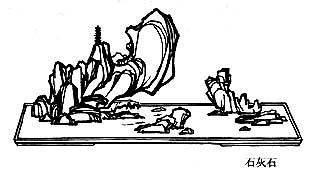三
十
六
計
36 Ji 
 – Thirty-Six Strategies
– Thirty-Six Strategies
A recently uncovered notebook of 36 proverbs commented as military tactics that helps dealing with conflicts. Tr. Verstappen (en), Doc Mac Jr (fr).
25. 偷
樑
換
柱
Replace The Beams With Rotten Timbers
26. 指
桑
罵
槐
Point At The Mulberry But Curse The Locust Tree
27. 假
癡
不
癲
Feign Madness But Keep Your Balance
28. 上
屋
抽
梯
Lure Your Enemy Onto the Roof, Then Take Away the Ladder
29. 樹
上
開
花
Tie Silk Blossoms to the Dead Tree
30. 反
客
為
主
Exchange the Role of Guest for that of Host
36ji V. 25.
Replace The Beams With Rotten Timbers
Disrupt the enemy's formations, interfere with their methods of operations, change the rules in which they are used to following, go contrary to their standard training. In this way you remove the supporting pillar, the common link that makes a group of men an effective fighting force.
Six Dynasties Period China
In 383 emperor Fu Jian of Qin, personally led an advance guard of 5,000 horses to attack the Jin general Xie Shi. Discovering that the Jin forces were greater than he anticipated, the emperor had his army form defensive positions along the bank of the river. The Jin armies likewise encamped on the opposite side. Neither side wished to cross first since it was well known that an army is most vulnerable when crossing a river. General Shi sent an envoy across the river with a message that read: " My lord, your army has entered deeply into our territory, and in deploying your ranks you have crowded upon the river. This is the plan for a lengthy stalemate. Do you really want to fight? If you will order your men to withdraw to a safe distance and allow us to cross we can then fight it out and settle the matter quickly."
The emperor agreed to the request. When his advisors objected, emperor Fu Jian told them that he planned to turn his army about and attack the Jin after half their troops had crossed. But general Xie anticipated the emperor's treachery and sent scouts disguised as imperial troops to infiltrate the Qin ranks. When the emperor ordered his army to pull back, the disguised Jin troops began to incite panic by spreading the rumor that Qin was withdrawing in defeat and that Jin was in hot pursuit. The retreat quickly turned into a rout as the Qin troops broke formation to escape. The emperor and his generals raced frantically after the fleeing soldiers with whips in hand to stop them, but to no avail. The Jin army quickly crossed the river and pursued the Qin forces inflicting enormous casualties. The emperor was wounded and narrowly escaped. He was captured and strangled a few weeks later.
Verstappen
« Voler les poutres, échanger les piliers »
Sabote, immobilise ou détruit ton adversaire
en lui ôtant la clef de son soutien.
Pousser l'ennemi à changer fréquemment son dispositif de bataille, disloquer sa force principale et faire souffler un vent de panique lorsqu'il est proche de la défaite.
Stopper la roue.*
Depuis la plus haute antiquité les « formations de bataille » sont une caractéristique de l'histoire militaire de la Chine. Une formation typique possède un « axe central » (poutre du Ciel) s'étendant de l'avant à l'arrière, et un « axe horizontal » (pilier de la Terre) mettant en relation les flancs gauche et droit. Les deux axes, composés des meilleurs combattants, servent à maintenir la cohérence de la formation. Quand elle est assaillie, une formation ne cèdera le passage qui lorsque ces deux axes seront disloqués. Par conséquent, l'attaquant devra employer un groupe de choc pour briser la formation adverse et en déplacer les axes. Il peut aussi user de ruses pour semer le désordre dans la structure ennemie avant de lancer une attaque frontale.
Cette stratégie fait également référence à un principe général : semer la confusion dans les rangs ennemis avant de l'engager dans la bataille. De cette façon, vous pourrez mettre à nu et combattre le centre vital du dispositif de l'adversaire.
N.B. : D'autres commentateurs comprennent ce stratagème comme une invitation à démembrer l'armée de vos propres alliés afin de vous accaparer leurs troupes d'élites et de contrôler leurs forces pour qu'ils ne puissent se retourner contre vous. « Ceci est la meilleure tactique lorsque l'on doit combattre un ennemi aux côtés d'un autre ennemi que l'on souhaite annexer. »
* Texte de l'hexagramme n°64 du Yi Jing : Wei Ji (avant l'accomplissement)... Dans cette stratégie, les troupes sont comparées à un char de guerre et l'axe de son ordre de bataille aux roues.
Doc Mac Jr

Thirty–Six Strategies – 36 Ji V. 25. – Chinese on/off – Français/English
AliasThirty-Six Strategies, Thirty-Six Stratagems, Secret Art of War, Les 36 stratagèmes, Les Trente-six stratégies
The Book of Odes, The Analects, Great Learning, Doctrine of the Mean, Three-characters book, The Book of Changes, The Way and its Power, 300 Tang Poems, The Art of War, Thirty-Six Strategies
Welcome, help, notes, introduction, table.
Index – Contact – Top
